Business Law Report: UK Legal System, Formation, and Disputes
VerifiedAdded on 2022/11/29
|13
|3939
|329
Report
AI Summary
This report provides an overview of UK business law, covering various aspects such as the sources of law (primary and secondary), the law-making process, and the role of government. It delves into the impact of legislation on business enterprises, focusing on contract law, employment law, and company law. The report also explores different legal forms of businesses in the UK, including sole proprietorships and partnerships, along with their management and funding. Finally, it offers recommendations for legal solutions to dispute resolution, providing a comprehensive understanding of the legal landscape for businesses operating in the United Kingdom. The report is designed to provide a solid foundation in the principles of business law and its practical applications within the UK context.
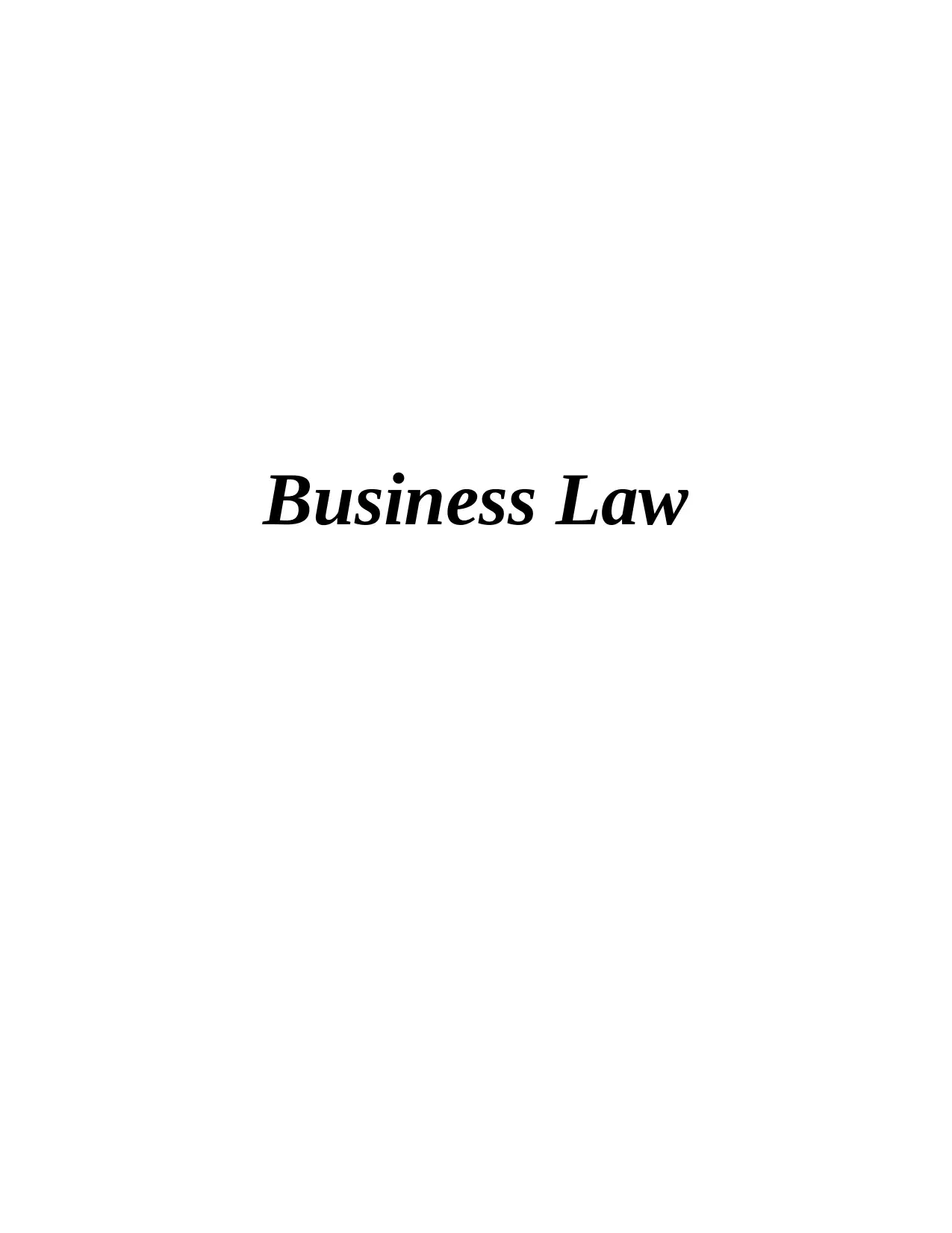
Business Law
Paraphrase This Document
Need a fresh take? Get an instant paraphrase of this document with our AI Paraphraser
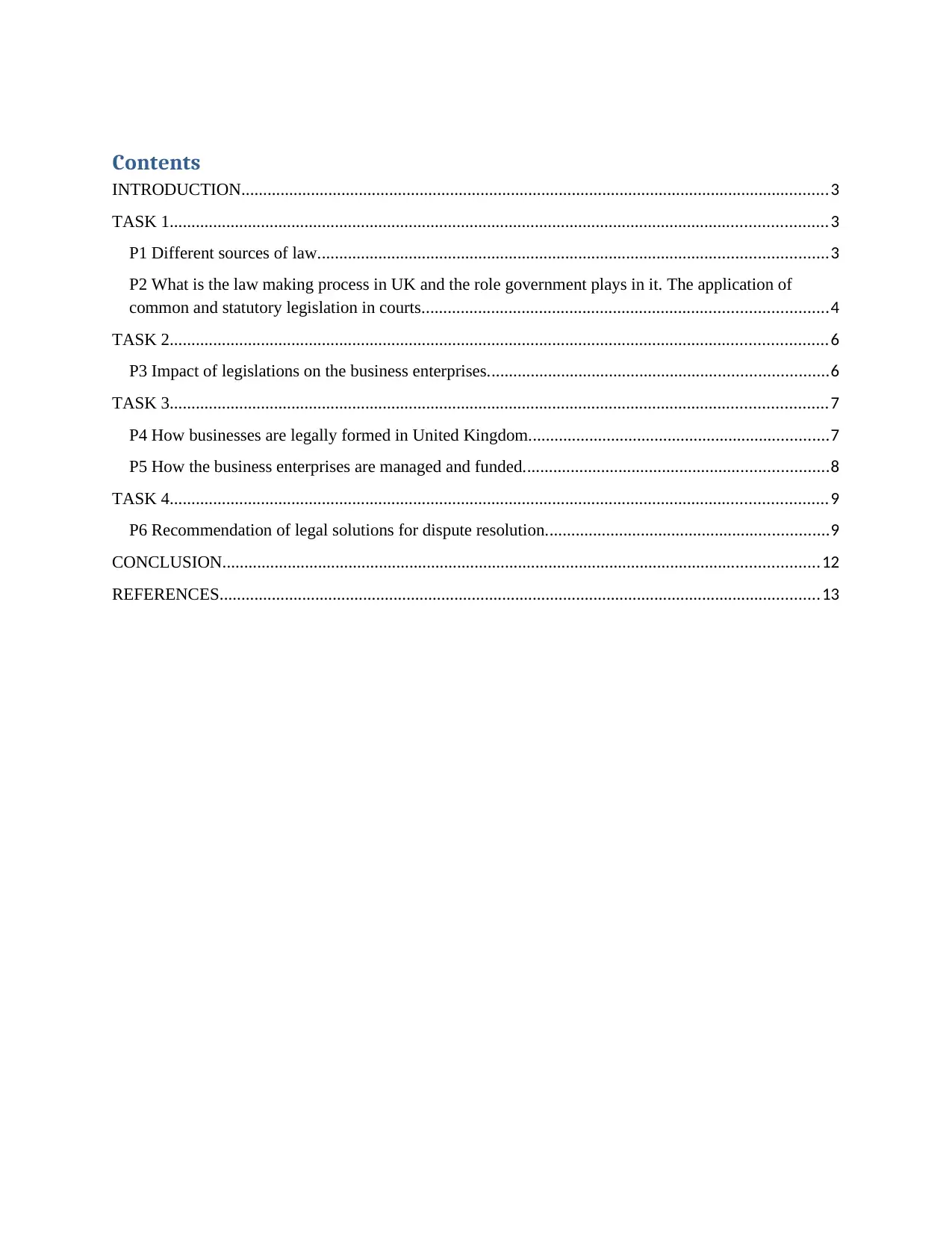
Contents
INTRODUCTION.......................................................................................................................................3
TASK 1.......................................................................................................................................................3
P1 Different sources of law.....................................................................................................................3
P2 What is the law making process in UK and the role government plays in it. The application of
common and statutory legislation in courts.............................................................................................4
TASK 2.......................................................................................................................................................6
P3 Impact of legislations on the business enterprises..............................................................................6
TASK 3.......................................................................................................................................................7
P4 How businesses are legally formed in United Kingdom.....................................................................7
P5 How the business enterprises are managed and funded......................................................................8
TASK 4.......................................................................................................................................................9
P6 Recommendation of legal solutions for dispute resolution.................................................................9
CONCLUSION.........................................................................................................................................12
REFERENCES..........................................................................................................................................13
INTRODUCTION.......................................................................................................................................3
TASK 1.......................................................................................................................................................3
P1 Different sources of law.....................................................................................................................3
P2 What is the law making process in UK and the role government plays in it. The application of
common and statutory legislation in courts.............................................................................................4
TASK 2.......................................................................................................................................................6
P3 Impact of legislations on the business enterprises..............................................................................6
TASK 3.......................................................................................................................................................7
P4 How businesses are legally formed in United Kingdom.....................................................................7
P5 How the business enterprises are managed and funded......................................................................8
TASK 4.......................................................................................................................................................9
P6 Recommendation of legal solutions for dispute resolution.................................................................9
CONCLUSION.........................................................................................................................................12
REFERENCES..........................................................................................................................................13
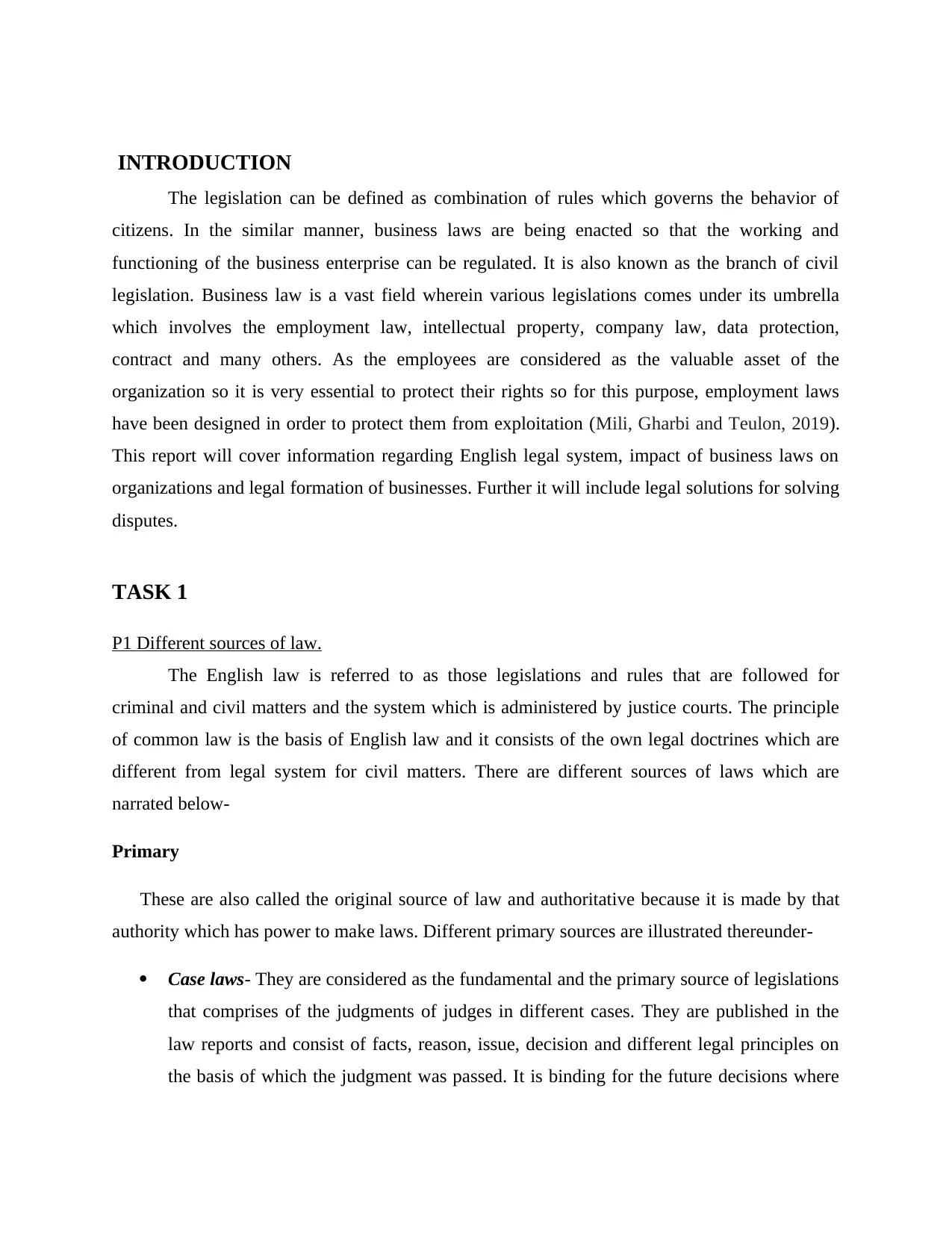
INTRODUCTION
The legislation can be defined as combination of rules which governs the behavior of
citizens. In the similar manner, business laws are being enacted so that the working and
functioning of the business enterprise can be regulated. It is also known as the branch of civil
legislation. Business law is a vast field wherein various legislations comes under its umbrella
which involves the employment law, intellectual property, company law, data protection,
contract and many others. As the employees are considered as the valuable asset of the
organization so it is very essential to protect their rights so for this purpose, employment laws
have been designed in order to protect them from exploitation (Mili, Gharbi and Teulon, 2019).
This report will cover information regarding English legal system, impact of business laws on
organizations and legal formation of businesses. Further it will include legal solutions for solving
disputes.
TASK 1
P1 Different sources of law.
The English law is referred to as those legislations and rules that are followed for
criminal and civil matters and the system which is administered by justice courts. The principle
of common law is the basis of English law and it consists of the own legal doctrines which are
different from legal system for civil matters. There are different sources of laws which are
narrated below-
Primary
These are also called the original source of law and authoritative because it is made by that
authority which has power to make laws. Different primary sources are illustrated thereunder-
Case laws- They are considered as the fundamental and the primary source of legislations
that comprises of the judgments of judges in different cases. They are published in the
law reports and consist of facts, reason, issue, decision and different legal principles on
the basis of which the judgment was passed. It is binding for the future decisions where
The legislation can be defined as combination of rules which governs the behavior of
citizens. In the similar manner, business laws are being enacted so that the working and
functioning of the business enterprise can be regulated. It is also known as the branch of civil
legislation. Business law is a vast field wherein various legislations comes under its umbrella
which involves the employment law, intellectual property, company law, data protection,
contract and many others. As the employees are considered as the valuable asset of the
organization so it is very essential to protect their rights so for this purpose, employment laws
have been designed in order to protect them from exploitation (Mili, Gharbi and Teulon, 2019).
This report will cover information regarding English legal system, impact of business laws on
organizations and legal formation of businesses. Further it will include legal solutions for solving
disputes.
TASK 1
P1 Different sources of law.
The English law is referred to as those legislations and rules that are followed for
criminal and civil matters and the system which is administered by justice courts. The principle
of common law is the basis of English law and it consists of the own legal doctrines which are
different from legal system for civil matters. There are different sources of laws which are
narrated below-
Primary
These are also called the original source of law and authoritative because it is made by that
authority which has power to make laws. Different primary sources are illustrated thereunder-
Case laws- They are considered as the fundamental and the primary source of legislations
that comprises of the judgments of judges in different cases. They are published in the
law reports and consist of facts, reason, issue, decision and different legal principles on
the basis of which the judgment was passed. It is binding for the future decisions where
⊘ This is a preview!⊘
Do you want full access?
Subscribe today to unlock all pages.

Trusted by 1+ million students worldwide
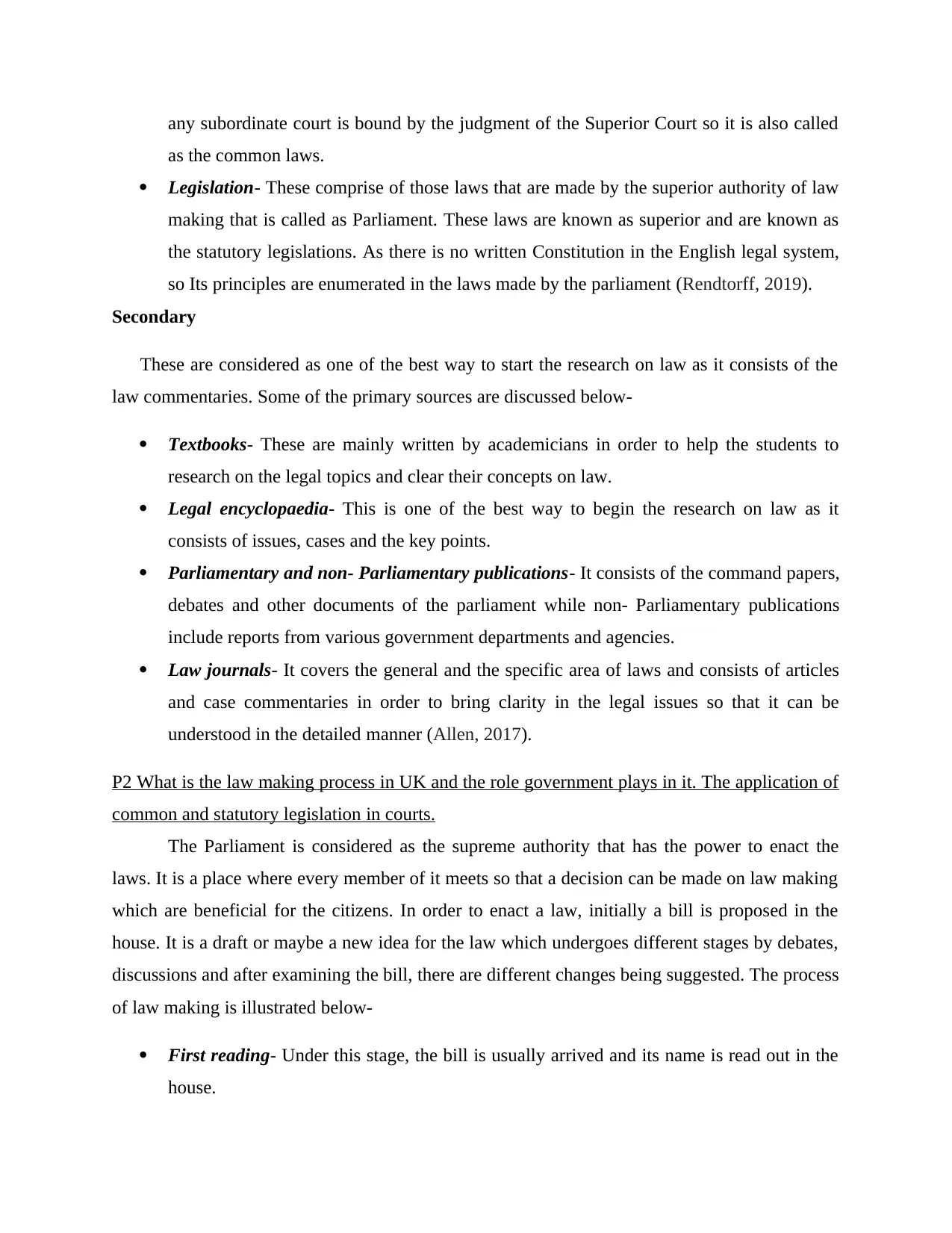
any subordinate court is bound by the judgment of the Superior Court so it is also called
as the common laws.
Legislation- These comprise of those laws that are made by the superior authority of law
making that is called as Parliament. These laws are known as superior and are known as
the statutory legislations. As there is no written Constitution in the English legal system,
so Its principles are enumerated in the laws made by the parliament (Rendtorff, 2019).
Secondary
These are considered as one of the best way to start the research on law as it consists of the
law commentaries. Some of the primary sources are discussed below-
Textbooks- These are mainly written by academicians in order to help the students to
research on the legal topics and clear their concepts on law.
Legal encyclopaedia- This is one of the best way to begin the research on law as it
consists of issues, cases and the key points.
Parliamentary and non- Parliamentary publications- It consists of the command papers,
debates and other documents of the parliament while non- Parliamentary publications
include reports from various government departments and agencies.
Law journals- It covers the general and the specific area of laws and consists of articles
and case commentaries in order to bring clarity in the legal issues so that it can be
understood in the detailed manner (Allen, 2017).
P2 What is the law making process in UK and the role government plays in it. The application of
common and statutory legislation in courts.
The Parliament is considered as the supreme authority that has the power to enact the
laws. It is a place where every member of it meets so that a decision can be made on law making
which are beneficial for the citizens. In order to enact a law, initially a bill is proposed in the
house. It is a draft or maybe a new idea for the law which undergoes different stages by debates,
discussions and after examining the bill, there are different changes being suggested. The process
of law making is illustrated below-
First reading- Under this stage, the bill is usually arrived and its name is read out in the
house.
as the common laws.
Legislation- These comprise of those laws that are made by the superior authority of law
making that is called as Parliament. These laws are known as superior and are known as
the statutory legislations. As there is no written Constitution in the English legal system,
so Its principles are enumerated in the laws made by the parliament (Rendtorff, 2019).
Secondary
These are considered as one of the best way to start the research on law as it consists of the
law commentaries. Some of the primary sources are discussed below-
Textbooks- These are mainly written by academicians in order to help the students to
research on the legal topics and clear their concepts on law.
Legal encyclopaedia- This is one of the best way to begin the research on law as it
consists of issues, cases and the key points.
Parliamentary and non- Parliamentary publications- It consists of the command papers,
debates and other documents of the parliament while non- Parliamentary publications
include reports from various government departments and agencies.
Law journals- It covers the general and the specific area of laws and consists of articles
and case commentaries in order to bring clarity in the legal issues so that it can be
understood in the detailed manner (Allen, 2017).
P2 What is the law making process in UK and the role government plays in it. The application of
common and statutory legislation in courts.
The Parliament is considered as the supreme authority that has the power to enact the
laws. It is a place where every member of it meets so that a decision can be made on law making
which are beneficial for the citizens. In order to enact a law, initially a bill is proposed in the
house. It is a draft or maybe a new idea for the law which undergoes different stages by debates,
discussions and after examining the bill, there are different changes being suggested. The process
of law making is illustrated below-
First reading- Under this stage, the bill is usually arrived and its name is read out in the
house.
Paraphrase This Document
Need a fresh take? Get an instant paraphrase of this document with our AI Paraphraser
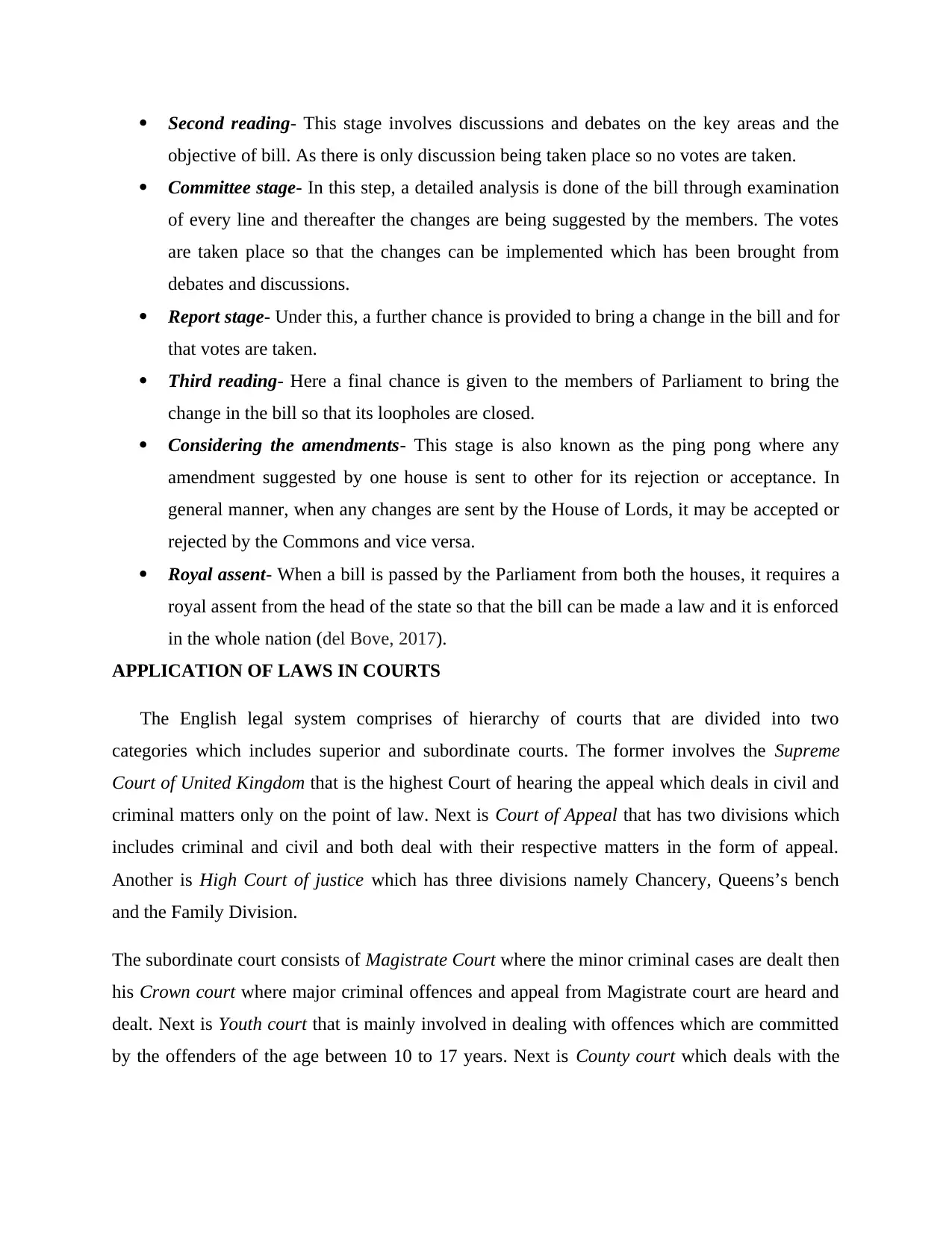
Second reading- This stage involves discussions and debates on the key areas and the
objective of bill. As there is only discussion being taken place so no votes are taken.
Committee stage- In this step, a detailed analysis is done of the bill through examination
of every line and thereafter the changes are being suggested by the members. The votes
are taken place so that the changes can be implemented which has been brought from
debates and discussions.
Report stage- Under this, a further chance is provided to bring a change in the bill and for
that votes are taken.
Third reading- Here a final chance is given to the members of Parliament to bring the
change in the bill so that its loopholes are closed.
Considering the amendments- This stage is also known as the ping pong where any
amendment suggested by one house is sent to other for its rejection or acceptance. In
general manner, when any changes are sent by the House of Lords, it may be accepted or
rejected by the Commons and vice versa.
Royal assent- When a bill is passed by the Parliament from both the houses, it requires a
royal assent from the head of the state so that the bill can be made a law and it is enforced
in the whole nation (del Bove, 2017).
APPLICATION OF LAWS IN COURTS
The English legal system comprises of hierarchy of courts that are divided into two
categories which includes superior and subordinate courts. The former involves the Supreme
Court of United Kingdom that is the highest Court of hearing the appeal which deals in civil and
criminal matters only on the point of law. Next is Court of Appeal that has two divisions which
includes criminal and civil and both deal with their respective matters in the form of appeal.
Another is High Court of justice which has three divisions namely Chancery, Queens’s bench
and the Family Division.
The subordinate court consists of Magistrate Court where the minor criminal cases are dealt then
his Crown court where major criminal offences and appeal from Magistrate court are heard and
dealt. Next is Youth court that is mainly involved in dealing with offences which are committed
by the offenders of the age between 10 to 17 years. Next is County court which deals with the
objective of bill. As there is only discussion being taken place so no votes are taken.
Committee stage- In this step, a detailed analysis is done of the bill through examination
of every line and thereafter the changes are being suggested by the members. The votes
are taken place so that the changes can be implemented which has been brought from
debates and discussions.
Report stage- Under this, a further chance is provided to bring a change in the bill and for
that votes are taken.
Third reading- Here a final chance is given to the members of Parliament to bring the
change in the bill so that its loopholes are closed.
Considering the amendments- This stage is also known as the ping pong where any
amendment suggested by one house is sent to other for its rejection or acceptance. In
general manner, when any changes are sent by the House of Lords, it may be accepted or
rejected by the Commons and vice versa.
Royal assent- When a bill is passed by the Parliament from both the houses, it requires a
royal assent from the head of the state so that the bill can be made a law and it is enforced
in the whole nation (del Bove, 2017).
APPLICATION OF LAWS IN COURTS
The English legal system comprises of hierarchy of courts that are divided into two
categories which includes superior and subordinate courts. The former involves the Supreme
Court of United Kingdom that is the highest Court of hearing the appeal which deals in civil and
criminal matters only on the point of law. Next is Court of Appeal that has two divisions which
includes criminal and civil and both deal with their respective matters in the form of appeal.
Another is High Court of justice which has three divisions namely Chancery, Queens’s bench
and the Family Division.
The subordinate court consists of Magistrate Court where the minor criminal cases are dealt then
his Crown court where major criminal offences and appeal from Magistrate court are heard and
dealt. Next is Youth court that is mainly involved in dealing with offences which are committed
by the offenders of the age between 10 to 17 years. Next is County court which deals with the
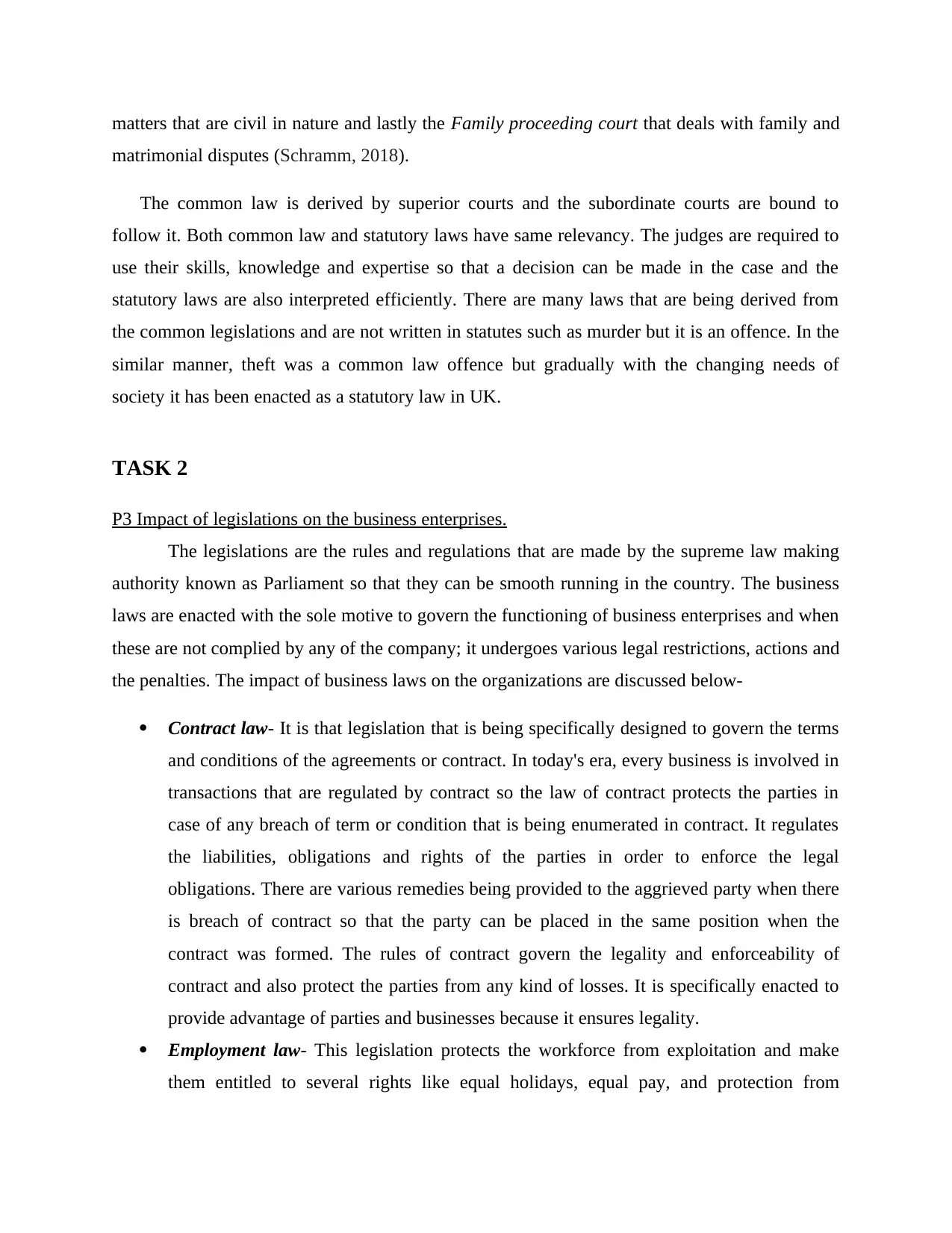
matters that are civil in nature and lastly the Family proceeding court that deals with family and
matrimonial disputes (Schramm, 2018).
The common law is derived by superior courts and the subordinate courts are bound to
follow it. Both common law and statutory laws have same relevancy. The judges are required to
use their skills, knowledge and expertise so that a decision can be made in the case and the
statutory laws are also interpreted efficiently. There are many laws that are being derived from
the common legislations and are not written in statutes such as murder but it is an offence. In the
similar manner, theft was a common law offence but gradually with the changing needs of
society it has been enacted as a statutory law in UK.
TASK 2
P3 Impact of legislations on the business enterprises.
The legislations are the rules and regulations that are made by the supreme law making
authority known as Parliament so that they can be smooth running in the country. The business
laws are enacted with the sole motive to govern the functioning of business enterprises and when
these are not complied by any of the company; it undergoes various legal restrictions, actions and
the penalties. The impact of business laws on the organizations are discussed below-
Contract law- It is that legislation that is being specifically designed to govern the terms
and conditions of the agreements or contract. In today's era, every business is involved in
transactions that are regulated by contract so the law of contract protects the parties in
case of any breach of term or condition that is being enumerated in contract. It regulates
the liabilities, obligations and rights of the parties in order to enforce the legal
obligations. There are various remedies being provided to the aggrieved party when there
is breach of contract so that the party can be placed in the same position when the
contract was formed. The rules of contract govern the legality and enforceability of
contract and also protect the parties from any kind of losses. It is specifically enacted to
provide advantage of parties and businesses because it ensures legality.
Employment law- This legislation protects the workforce from exploitation and make
them entitled to several rights like equal holidays, equal pay, and protection from
matrimonial disputes (Schramm, 2018).
The common law is derived by superior courts and the subordinate courts are bound to
follow it. Both common law and statutory laws have same relevancy. The judges are required to
use their skills, knowledge and expertise so that a decision can be made in the case and the
statutory laws are also interpreted efficiently. There are many laws that are being derived from
the common legislations and are not written in statutes such as murder but it is an offence. In the
similar manner, theft was a common law offence but gradually with the changing needs of
society it has been enacted as a statutory law in UK.
TASK 2
P3 Impact of legislations on the business enterprises.
The legislations are the rules and regulations that are made by the supreme law making
authority known as Parliament so that they can be smooth running in the country. The business
laws are enacted with the sole motive to govern the functioning of business enterprises and when
these are not complied by any of the company; it undergoes various legal restrictions, actions and
the penalties. The impact of business laws on the organizations are discussed below-
Contract law- It is that legislation that is being specifically designed to govern the terms
and conditions of the agreements or contract. In today's era, every business is involved in
transactions that are regulated by contract so the law of contract protects the parties in
case of any breach of term or condition that is being enumerated in contract. It regulates
the liabilities, obligations and rights of the parties in order to enforce the legal
obligations. There are various remedies being provided to the aggrieved party when there
is breach of contract so that the party can be placed in the same position when the
contract was formed. The rules of contract govern the legality and enforceability of
contract and also protect the parties from any kind of losses. It is specifically enacted to
provide advantage of parties and businesses because it ensures legality.
Employment law- This legislation protects the workforce from exploitation and make
them entitled to several rights like equal holidays, equal pay, and protection from
⊘ This is a preview!⊘
Do you want full access?
Subscribe today to unlock all pages.

Trusted by 1+ million students worldwide
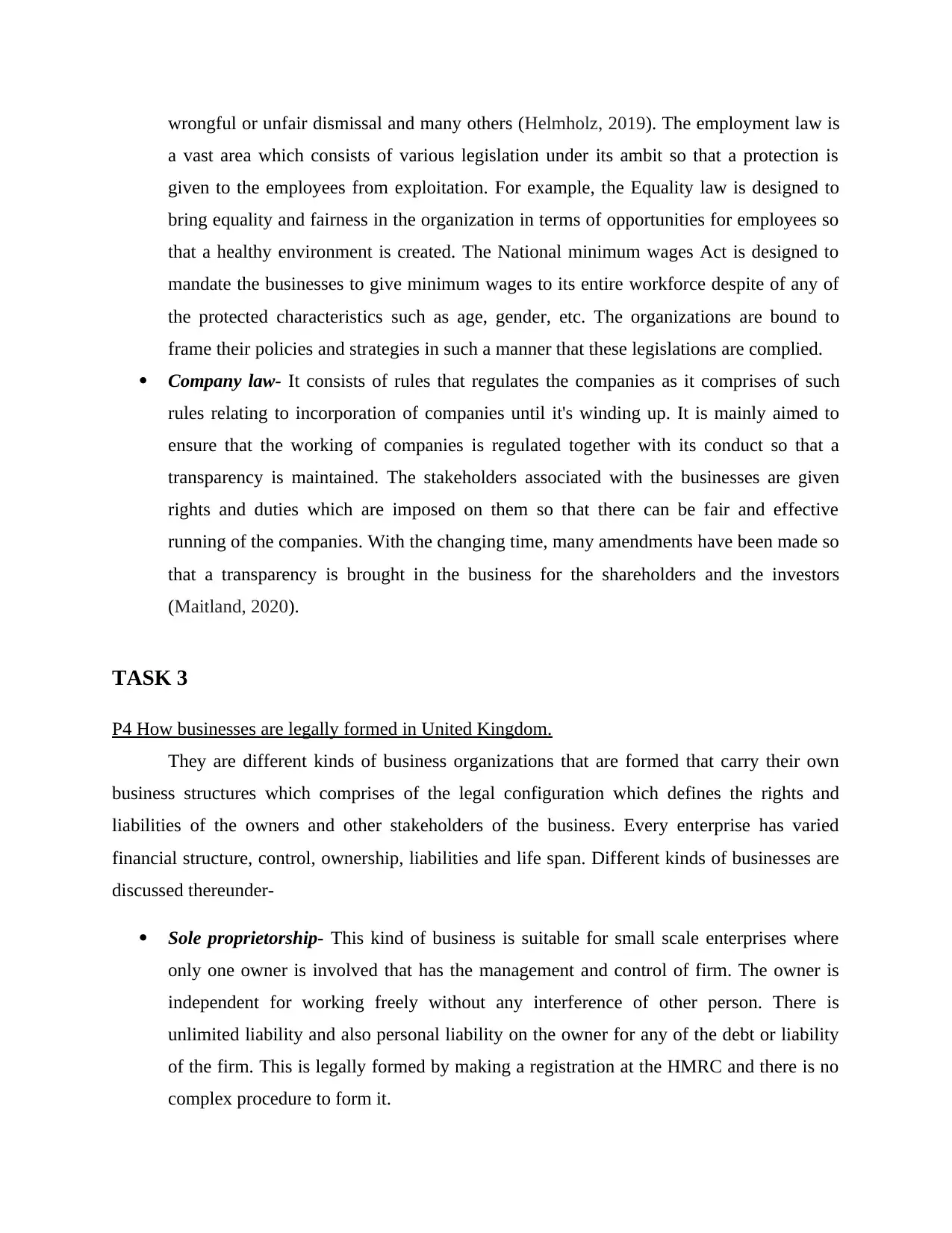
wrongful or unfair dismissal and many others (Helmholz, 2019). The employment law is
a vast area which consists of various legislation under its ambit so that a protection is
given to the employees from exploitation. For example, the Equality law is designed to
bring equality and fairness in the organization in terms of opportunities for employees so
that a healthy environment is created. The National minimum wages Act is designed to
mandate the businesses to give minimum wages to its entire workforce despite of any of
the protected characteristics such as age, gender, etc. The organizations are bound to
frame their policies and strategies in such a manner that these legislations are complied.
Company law- It consists of rules that regulates the companies as it comprises of such
rules relating to incorporation of companies until it's winding up. It is mainly aimed to
ensure that the working of companies is regulated together with its conduct so that a
transparency is maintained. The stakeholders associated with the businesses are given
rights and duties which are imposed on them so that there can be fair and effective
running of the companies. With the changing time, many amendments have been made so
that a transparency is brought in the business for the shareholders and the investors
(Maitland, 2020).
TASK 3
P4 How businesses are legally formed in United Kingdom.
They are different kinds of business organizations that are formed that carry their own
business structures which comprises of the legal configuration which defines the rights and
liabilities of the owners and other stakeholders of the business. Every enterprise has varied
financial structure, control, ownership, liabilities and life span. Different kinds of businesses are
discussed thereunder-
Sole proprietorship- This kind of business is suitable for small scale enterprises where
only one owner is involved that has the management and control of firm. The owner is
independent for working freely without any interference of other person. There is
unlimited liability and also personal liability on the owner for any of the debt or liability
of the firm. This is legally formed by making a registration at the HMRC and there is no
complex procedure to form it.
a vast area which consists of various legislation under its ambit so that a protection is
given to the employees from exploitation. For example, the Equality law is designed to
bring equality and fairness in the organization in terms of opportunities for employees so
that a healthy environment is created. The National minimum wages Act is designed to
mandate the businesses to give minimum wages to its entire workforce despite of any of
the protected characteristics such as age, gender, etc. The organizations are bound to
frame their policies and strategies in such a manner that these legislations are complied.
Company law- It consists of rules that regulates the companies as it comprises of such
rules relating to incorporation of companies until it's winding up. It is mainly aimed to
ensure that the working of companies is regulated together with its conduct so that a
transparency is maintained. The stakeholders associated with the businesses are given
rights and duties which are imposed on them so that there can be fair and effective
running of the companies. With the changing time, many amendments have been made so
that a transparency is brought in the business for the shareholders and the investors
(Maitland, 2020).
TASK 3
P4 How businesses are legally formed in United Kingdom.
They are different kinds of business organizations that are formed that carry their own
business structures which comprises of the legal configuration which defines the rights and
liabilities of the owners and other stakeholders of the business. Every enterprise has varied
financial structure, control, ownership, liabilities and life span. Different kinds of businesses are
discussed thereunder-
Sole proprietorship- This kind of business is suitable for small scale enterprises where
only one owner is involved that has the management and control of firm. The owner is
independent for working freely without any interference of other person. There is
unlimited liability and also personal liability on the owner for any of the debt or liability
of the firm. This is legally formed by making a registration at the HMRC and there is no
complex procedure to form it.
Paraphrase This Document
Need a fresh take? Get an instant paraphrase of this document with our AI Paraphraser
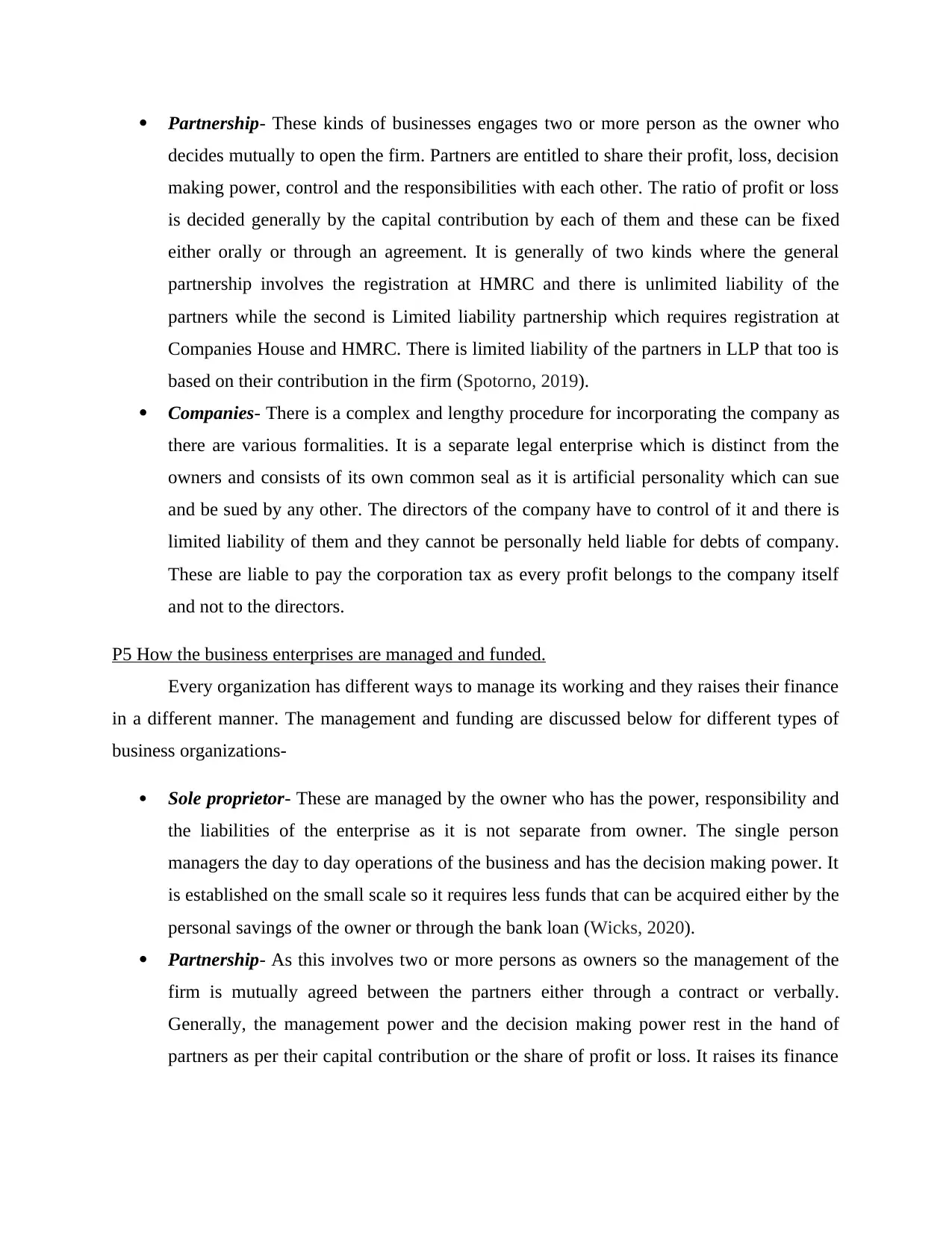
Partnership- These kinds of businesses engages two or more person as the owner who
decides mutually to open the firm. Partners are entitled to share their profit, loss, decision
making power, control and the responsibilities with each other. The ratio of profit or loss
is decided generally by the capital contribution by each of them and these can be fixed
either orally or through an agreement. It is generally of two kinds where the general
partnership involves the registration at HMRC and there is unlimited liability of the
partners while the second is Limited liability partnership which requires registration at
Companies House and HMRC. There is limited liability of the partners in LLP that too is
based on their contribution in the firm (Spotorno, 2019).
Companies- There is a complex and lengthy procedure for incorporating the company as
there are various formalities. It is a separate legal enterprise which is distinct from the
owners and consists of its own common seal as it is artificial personality which can sue
and be sued by any other. The directors of the company have to control of it and there is
limited liability of them and they cannot be personally held liable for debts of company.
These are liable to pay the corporation tax as every profit belongs to the company itself
and not to the directors.
P5 How the business enterprises are managed and funded.
Every organization has different ways to manage its working and they raises their finance
in a different manner. The management and funding are discussed below for different types of
business organizations-
Sole proprietor- These are managed by the owner who has the power, responsibility and
the liabilities of the enterprise as it is not separate from owner. The single person
managers the day to day operations of the business and has the decision making power. It
is established on the small scale so it requires less funds that can be acquired either by the
personal savings of the owner or through the bank loan (Wicks, 2020).
Partnership- As this involves two or more persons as owners so the management of the
firm is mutually agreed between the partners either through a contract or verbally.
Generally, the management power and the decision making power rest in the hand of
partners as per their capital contribution or the share of profit or loss. It raises its finance
decides mutually to open the firm. Partners are entitled to share their profit, loss, decision
making power, control and the responsibilities with each other. The ratio of profit or loss
is decided generally by the capital contribution by each of them and these can be fixed
either orally or through an agreement. It is generally of two kinds where the general
partnership involves the registration at HMRC and there is unlimited liability of the
partners while the second is Limited liability partnership which requires registration at
Companies House and HMRC. There is limited liability of the partners in LLP that too is
based on their contribution in the firm (Spotorno, 2019).
Companies- There is a complex and lengthy procedure for incorporating the company as
there are various formalities. It is a separate legal enterprise which is distinct from the
owners and consists of its own common seal as it is artificial personality which can sue
and be sued by any other. The directors of the company have to control of it and there is
limited liability of them and they cannot be personally held liable for debts of company.
These are liable to pay the corporation tax as every profit belongs to the company itself
and not to the directors.
P5 How the business enterprises are managed and funded.
Every organization has different ways to manage its working and they raises their finance
in a different manner. The management and funding are discussed below for different types of
business organizations-
Sole proprietor- These are managed by the owner who has the power, responsibility and
the liabilities of the enterprise as it is not separate from owner. The single person
managers the day to day operations of the business and has the decision making power. It
is established on the small scale so it requires less funds that can be acquired either by the
personal savings of the owner or through the bank loan (Wicks, 2020).
Partnership- As this involves two or more persons as owners so the management of the
firm is mutually agreed between the partners either through a contract or verbally.
Generally, the management power and the decision making power rest in the hand of
partners as per their capital contribution or the share of profit or loss. It raises its finance
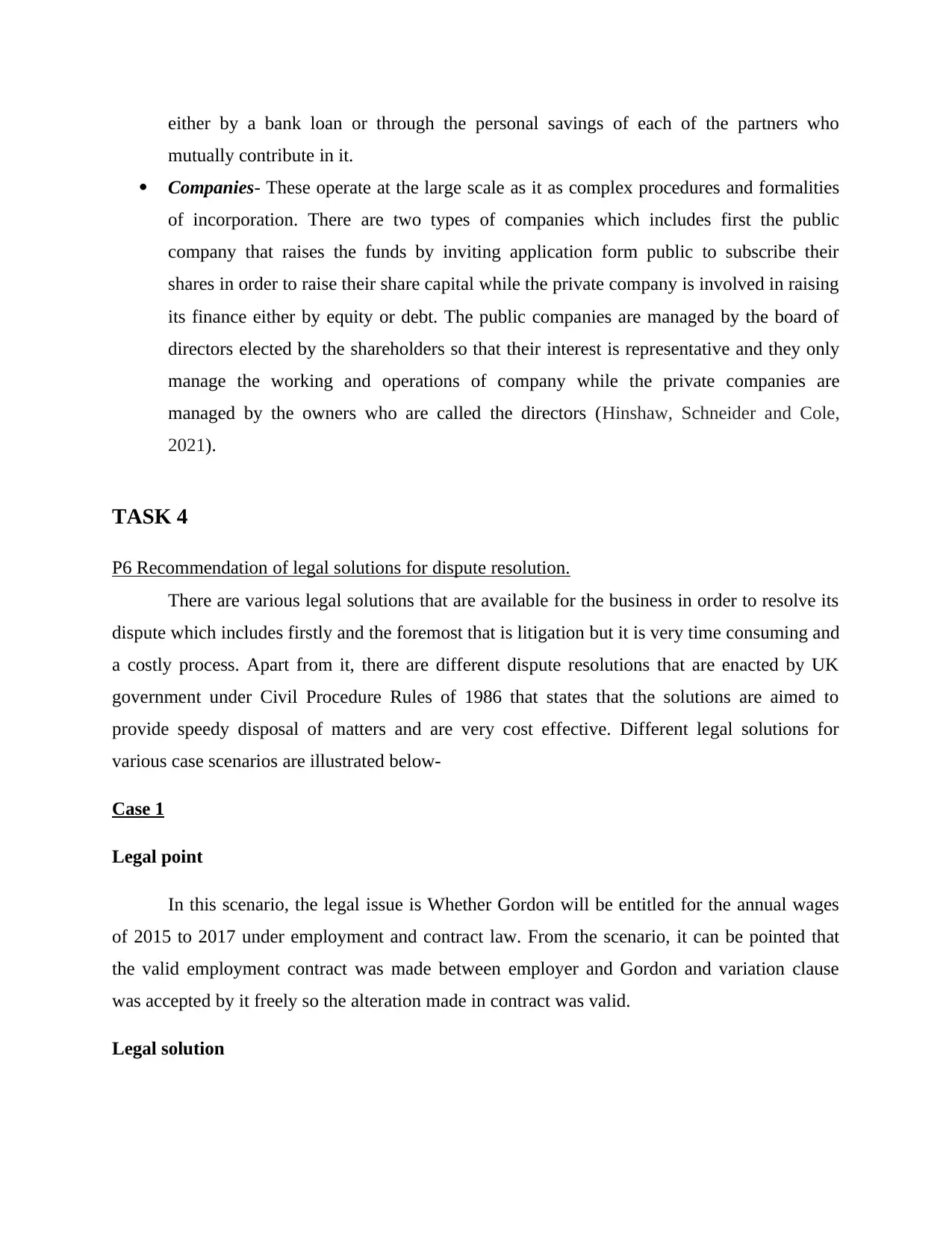
either by a bank loan or through the personal savings of each of the partners who
mutually contribute in it.
Companies- These operate at the large scale as it as complex procedures and formalities
of incorporation. There are two types of companies which includes first the public
company that raises the funds by inviting application form public to subscribe their
shares in order to raise their share capital while the private company is involved in raising
its finance either by equity or debt. The public companies are managed by the board of
directors elected by the shareholders so that their interest is representative and they only
manage the working and operations of company while the private companies are
managed by the owners who are called the directors (Hinshaw, Schneider and Cole,
2021).
TASK 4
P6 Recommendation of legal solutions for dispute resolution.
There are various legal solutions that are available for the business in order to resolve its
dispute which includes firstly and the foremost that is litigation but it is very time consuming and
a costly process. Apart from it, there are different dispute resolutions that are enacted by UK
government under Civil Procedure Rules of 1986 that states that the solutions are aimed to
provide speedy disposal of matters and are very cost effective. Different legal solutions for
various case scenarios are illustrated below-
Case 1
Legal point
In this scenario, the legal issue is Whether Gordon will be entitled for the annual wages
of 2015 to 2017 under employment and contract law. From the scenario, it can be pointed that
the valid employment contract was made between employer and Gordon and variation clause
was accepted by it freely so the alteration made in contract was valid.
Legal solution
mutually contribute in it.
Companies- These operate at the large scale as it as complex procedures and formalities
of incorporation. There are two types of companies which includes first the public
company that raises the funds by inviting application form public to subscribe their
shares in order to raise their share capital while the private company is involved in raising
its finance either by equity or debt. The public companies are managed by the board of
directors elected by the shareholders so that their interest is representative and they only
manage the working and operations of company while the private companies are
managed by the owners who are called the directors (Hinshaw, Schneider and Cole,
2021).
TASK 4
P6 Recommendation of legal solutions for dispute resolution.
There are various legal solutions that are available for the business in order to resolve its
dispute which includes firstly and the foremost that is litigation but it is very time consuming and
a costly process. Apart from it, there are different dispute resolutions that are enacted by UK
government under Civil Procedure Rules of 1986 that states that the solutions are aimed to
provide speedy disposal of matters and are very cost effective. Different legal solutions for
various case scenarios are illustrated below-
Case 1
Legal point
In this scenario, the legal issue is Whether Gordon will be entitled for the annual wages
of 2015 to 2017 under employment and contract law. From the scenario, it can be pointed that
the valid employment contract was made between employer and Gordon and variation clause
was accepted by it freely so the alteration made in contract was valid.
Legal solution
⊘ This is a preview!⊘
Do you want full access?
Subscribe today to unlock all pages.

Trusted by 1+ million students worldwide
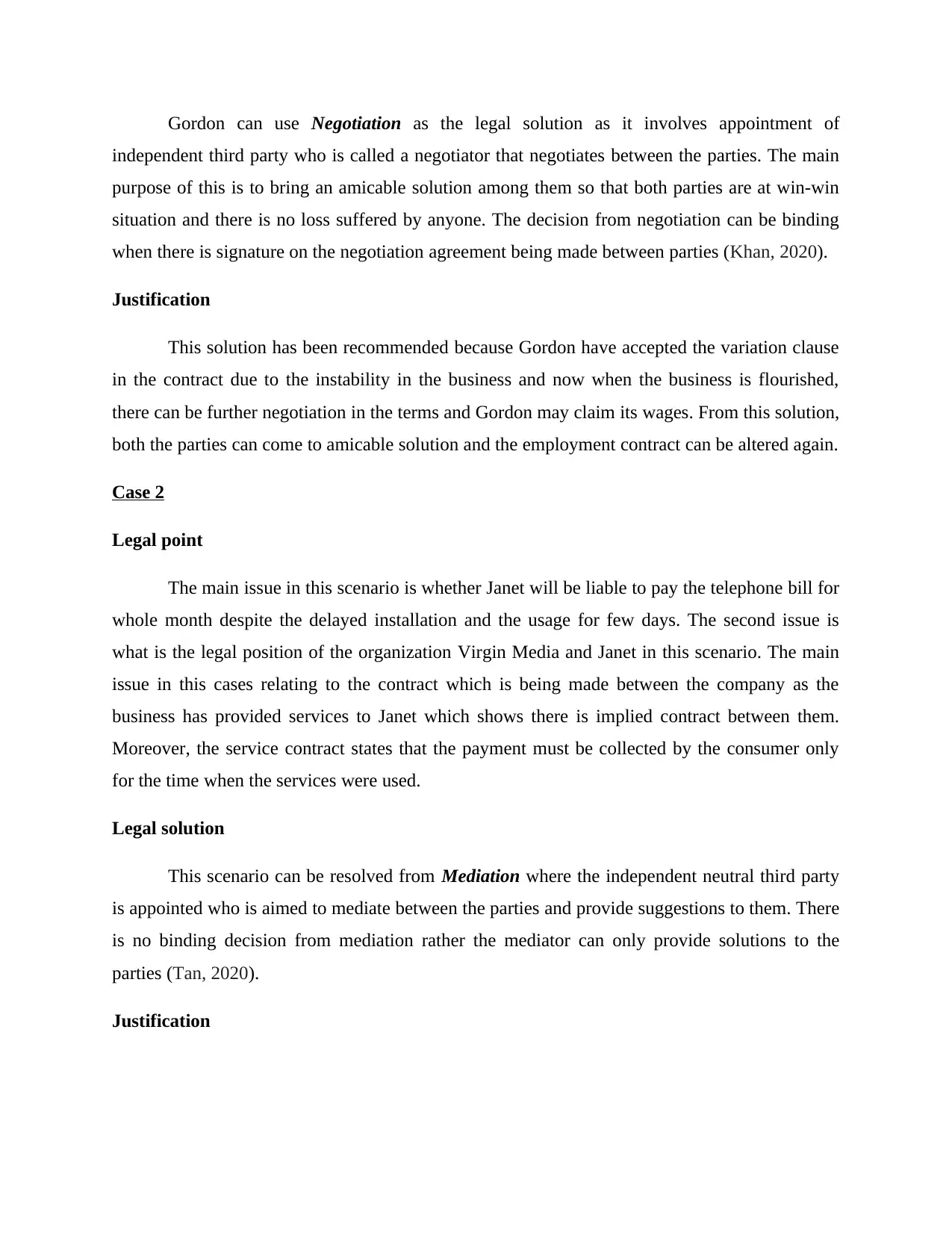
Gordon can use Negotiation as the legal solution as it involves appointment of
independent third party who is called a negotiator that negotiates between the parties. The main
purpose of this is to bring an amicable solution among them so that both parties are at win-win
situation and there is no loss suffered by anyone. The decision from negotiation can be binding
when there is signature on the negotiation agreement being made between parties (Khan, 2020).
Justification
This solution has been recommended because Gordon have accepted the variation clause
in the contract due to the instability in the business and now when the business is flourished,
there can be further negotiation in the terms and Gordon may claim its wages. From this solution,
both the parties can come to amicable solution and the employment contract can be altered again.
Case 2
Legal point
The main issue in this scenario is whether Janet will be liable to pay the telephone bill for
whole month despite the delayed installation and the usage for few days. The second issue is
what is the legal position of the organization Virgin Media and Janet in this scenario. The main
issue in this cases relating to the contract which is being made between the company as the
business has provided services to Janet which shows there is implied contract between them.
Moreover, the service contract states that the payment must be collected by the consumer only
for the time when the services were used.
Legal solution
This scenario can be resolved from Mediation where the independent neutral third party
is appointed who is aimed to mediate between the parties and provide suggestions to them. There
is no binding decision from mediation rather the mediator can only provide solutions to the
parties (Tan, 2020).
Justification
independent third party who is called a negotiator that negotiates between the parties. The main
purpose of this is to bring an amicable solution among them so that both parties are at win-win
situation and there is no loss suffered by anyone. The decision from negotiation can be binding
when there is signature on the negotiation agreement being made between parties (Khan, 2020).
Justification
This solution has been recommended because Gordon have accepted the variation clause
in the contract due to the instability in the business and now when the business is flourished,
there can be further negotiation in the terms and Gordon may claim its wages. From this solution,
both the parties can come to amicable solution and the employment contract can be altered again.
Case 2
Legal point
The main issue in this scenario is whether Janet will be liable to pay the telephone bill for
whole month despite the delayed installation and the usage for few days. The second issue is
what is the legal position of the organization Virgin Media and Janet in this scenario. The main
issue in this cases relating to the contract which is being made between the company as the
business has provided services to Janet which shows there is implied contract between them.
Moreover, the service contract states that the payment must be collected by the consumer only
for the time when the services were used.
Legal solution
This scenario can be resolved from Mediation where the independent neutral third party
is appointed who is aimed to mediate between the parties and provide suggestions to them. There
is no binding decision from mediation rather the mediator can only provide solutions to the
parties (Tan, 2020).
Justification
Paraphrase This Document
Need a fresh take? Get an instant paraphrase of this document with our AI Paraphraser
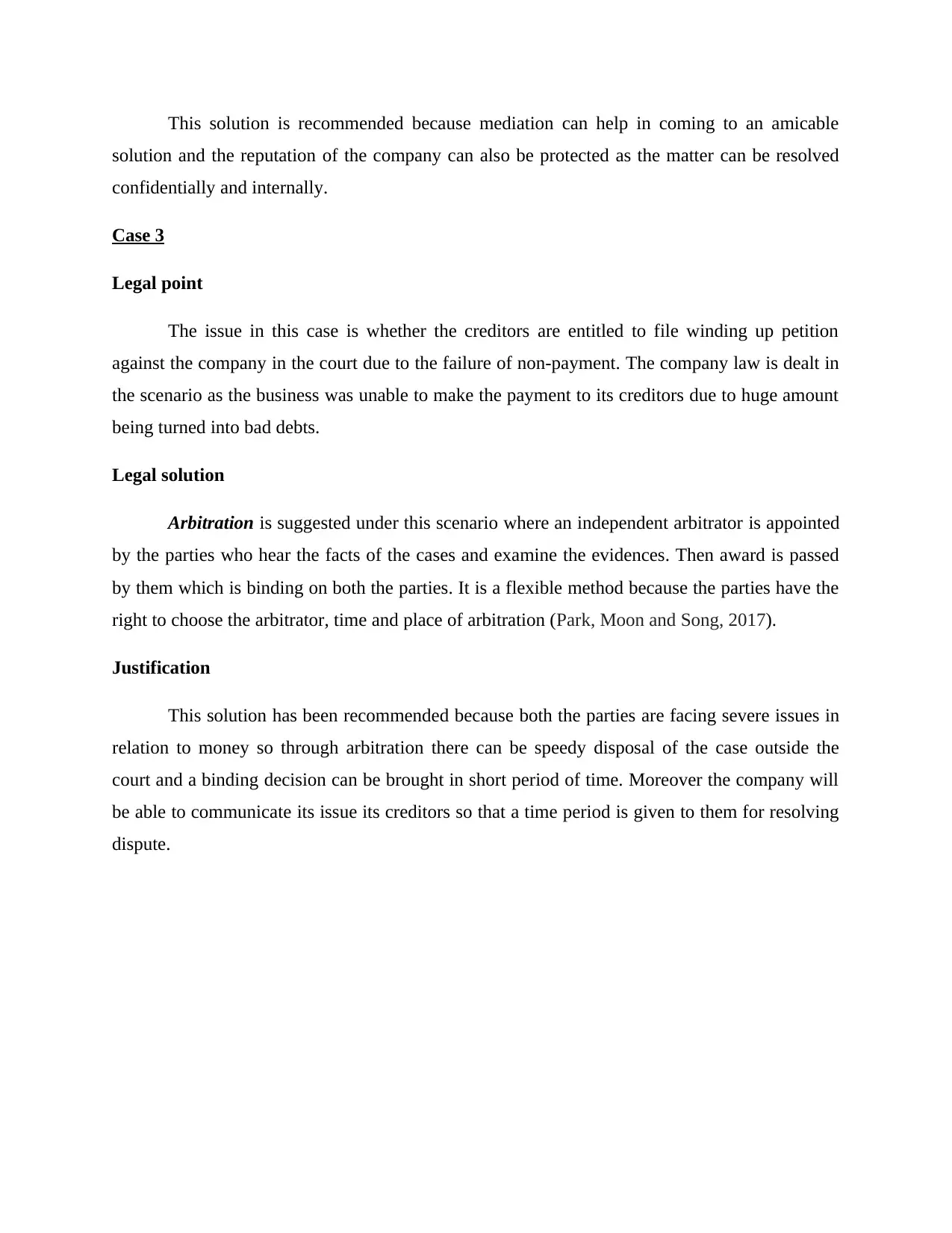
This solution is recommended because mediation can help in coming to an amicable
solution and the reputation of the company can also be protected as the matter can be resolved
confidentially and internally.
Case 3
Legal point
The issue in this case is whether the creditors are entitled to file winding up petition
against the company in the court due to the failure of non-payment. The company law is dealt in
the scenario as the business was unable to make the payment to its creditors due to huge amount
being turned into bad debts.
Legal solution
Arbitration is suggested under this scenario where an independent arbitrator is appointed
by the parties who hear the facts of the cases and examine the evidences. Then award is passed
by them which is binding on both the parties. It is a flexible method because the parties have the
right to choose the arbitrator, time and place of arbitration (Park, Moon and Song, 2017).
Justification
This solution has been recommended because both the parties are facing severe issues in
relation to money so through arbitration there can be speedy disposal of the case outside the
court and a binding decision can be brought in short period of time. Moreover the company will
be able to communicate its issue its creditors so that a time period is given to them for resolving
dispute.
solution and the reputation of the company can also be protected as the matter can be resolved
confidentially and internally.
Case 3
Legal point
The issue in this case is whether the creditors are entitled to file winding up petition
against the company in the court due to the failure of non-payment. The company law is dealt in
the scenario as the business was unable to make the payment to its creditors due to huge amount
being turned into bad debts.
Legal solution
Arbitration is suggested under this scenario where an independent arbitrator is appointed
by the parties who hear the facts of the cases and examine the evidences. Then award is passed
by them which is binding on both the parties. It is a flexible method because the parties have the
right to choose the arbitrator, time and place of arbitration (Park, Moon and Song, 2017).
Justification
This solution has been recommended because both the parties are facing severe issues in
relation to money so through arbitration there can be speedy disposal of the case outside the
court and a binding decision can be brought in short period of time. Moreover the company will
be able to communicate its issue its creditors so that a time period is given to them for resolving
dispute.
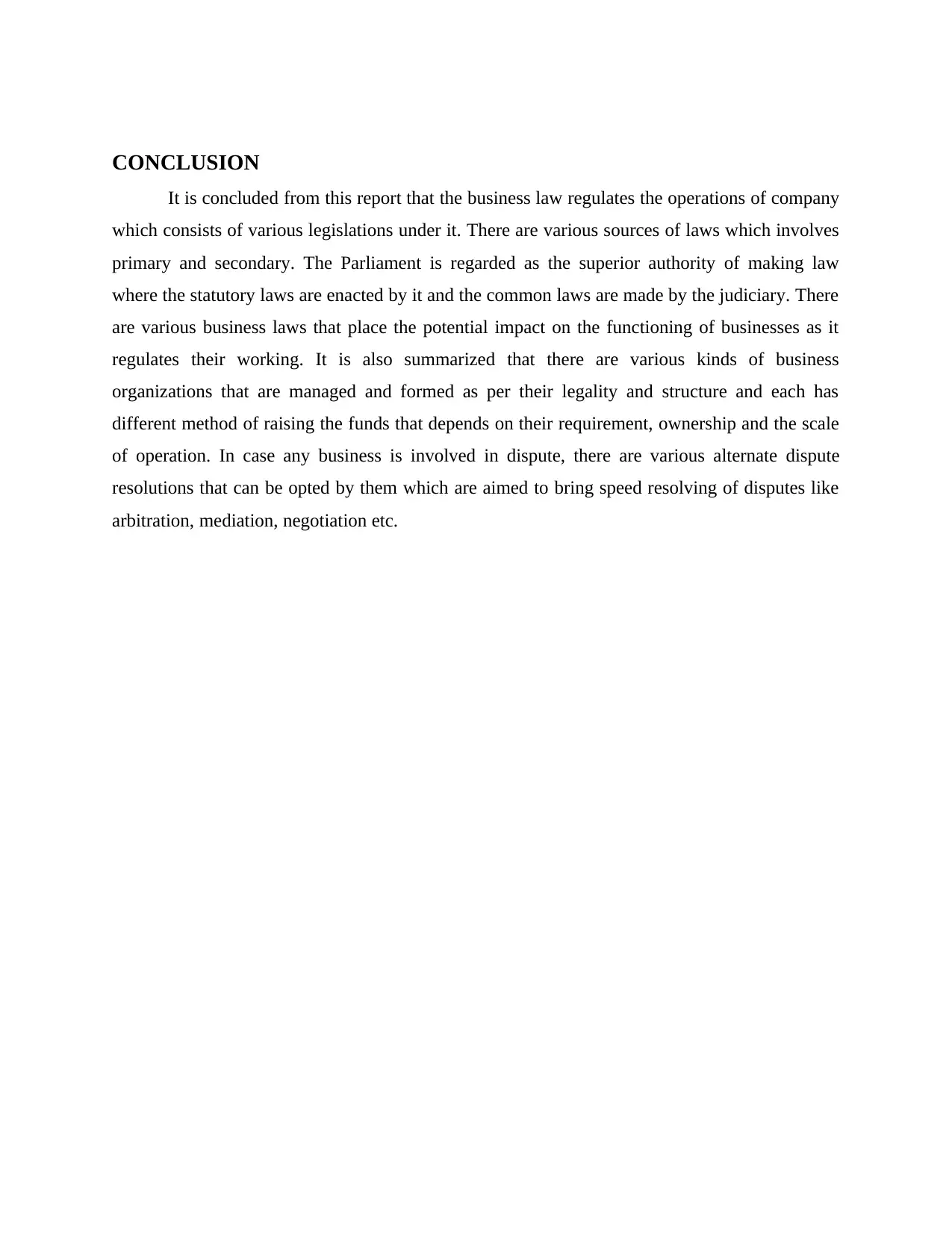
CONCLUSION
It is concluded from this report that the business law regulates the operations of company
which consists of various legislations under it. There are various sources of laws which involves
primary and secondary. The Parliament is regarded as the superior authority of making law
where the statutory laws are enacted by it and the common laws are made by the judiciary. There
are various business laws that place the potential impact on the functioning of businesses as it
regulates their working. It is also summarized that there are various kinds of business
organizations that are managed and formed as per their legality and structure and each has
different method of raising the funds that depends on their requirement, ownership and the scale
of operation. In case any business is involved in dispute, there are various alternate dispute
resolutions that can be opted by them which are aimed to bring speed resolving of disputes like
arbitration, mediation, negotiation etc.
It is concluded from this report that the business law regulates the operations of company
which consists of various legislations under it. There are various sources of laws which involves
primary and secondary. The Parliament is regarded as the superior authority of making law
where the statutory laws are enacted by it and the common laws are made by the judiciary. There
are various business laws that place the potential impact on the functioning of businesses as it
regulates their working. It is also summarized that there are various kinds of business
organizations that are managed and formed as per their legality and structure and each has
different method of raising the funds that depends on their requirement, ownership and the scale
of operation. In case any business is involved in dispute, there are various alternate dispute
resolutions that can be opted by them which are aimed to bring speed resolving of disputes like
arbitration, mediation, negotiation etc.
⊘ This is a preview!⊘
Do you want full access?
Subscribe today to unlock all pages.

Trusted by 1+ million students worldwide
1 out of 13
Related Documents
Your All-in-One AI-Powered Toolkit for Academic Success.
+13062052269
info@desklib.com
Available 24*7 on WhatsApp / Email
![[object Object]](/_next/static/media/star-bottom.7253800d.svg)
Unlock your academic potential
Copyright © 2020–2025 A2Z Services. All Rights Reserved. Developed and managed by ZUCOL.





